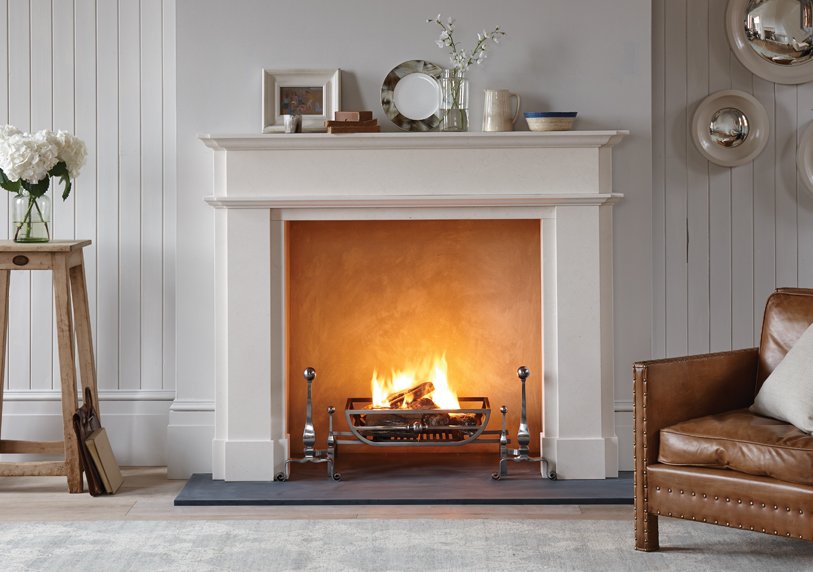Gas or Wood Burning: Which Fireplace Works Best in the UK?

Some people treat the fireplace like a prop. A background detail. Something that exists purely so they can hang a fake wreath on it at Christmas and forget about the rest of the year.
Others take it seriously. They want real flames. Real heat. And if there’s a smell of burning oak or the sound of a gas flame humming quietly while it works through the chill, even better. So a fire or stove is the go too answer.
So where do you stand?
And more importantly, where should you stand—especially if you live in Britain, where winter lasts half the year and spring is just winter with longer evenings?
Let’s start with the obvious.
Wood Burning Fireplaces
Wood burners have a certain appeal. It’s hard to beat the feeling of stacking logs in a neat pile, lighting a fire from scratch, and waiting patiently for the room to stop feeling like a meat locker.
They give you that smell. That crackle. That smug feeling of self-sufficiency. Like you’re off-grid, even though you’ve got a smart meter flashing next to your washing machine.
But they come with strings attached.
You need a regular supply of dry wood. Not wet. Not “this’ll do.” Proper seasoned logs, or you’ll spend more time cleaning the glass than enjoying the fire.
There’s the ash. The soot. The fact that it takes longer to get going than most central heating.
And let’s not forget the rules. Some towns and cities have clean air zones, which means you can only use certain types of stove and fuel. That means shopping with your reading glasses on, checking packaging for words like “DEFRA approved” and wondering if you’ve just been tricked into buying kindling made of recycled biscuits.
But once it’s going—if you’ve done it right—a wood fire has a charm you can’t fake. It glows. It moves. It turns a cold room into something you want to sit in, even without a phone in your hand.
Gas Fireplaces
Now for the other option. Gas.
No logs. No ash. No mess.
You push a button, and the fire appears like magic. It’s always the same. Warm. Steady. Predictable. Like a Labrador that doesn’t bark.
For people who don’t want to babysit their heating or don’t trust themselves with firelighters, a gas fireplace makes life easier.
You can get models that look like they burn wood. The logs don’t change, of course. They’re fake. But they’re convincing enough. No one’s going to call you a liar if you invite them over and serve tea next to your gas flame. And if they do, don’t invite them again.
Gas fires are easier to control. You want heat? You’ve got it in seconds. You want less? Turn it down. Try doing that with a stubborn log that’s suddenly turned into lava.
The running costs are better than electric, though not as cheap as lighting a free pile of branches you found behind the garage. But they don’t require wood storage. Or mess. Or three attempts to get a flame going because you forgot to open the vent.
Which One Works Best in the UK?
It depends on the kind of person you are.
Go wood if:
- You live in the countryside or have room to store logs
- You like the smell and don’t mind the mess
- You don’t need instant heat
- You enjoy doing things the long way for the sake of tradition
Go gas if:
- You live in a town or city
- You want clean, fast heat
- You’re not interested in buying a log basket or cleaning out ashes
- You’ve got better things to do than coax a flame for 20 minutes
Both types can heat a room well. Both look good if chosen carefully. But they offer very different experiences.
Wood fires are moody, dramatic, and slightly needy. Gas is tidy, fast, and always ready when you are. One is a partner who writes poems. The other remembers to pay the council tax.
Other Bits People Don’t Tell You
- Installation: Wood burners need a proper flue and may require changes to the chimney. Gas fires need a gas supply, obviously, and that might mean digging through walls.
- Cleaning: You’ll clean a wood burner more often than you think. Gas fires barely need it.
- Repairs: Wood burners rarely break. Gas fires have more working parts, which means more things can go wrong.
- Looks: A badly chosen stove in a period home will look like you gave up halfway through decorating. Choose one that fits the house, not one that fits the sale flyer.
So What’s the Verdict?
There isn’t one.
There’s just you. Your house. Your routine. Your ability to store half a forest in your garden shed without being accused of starting a new religion.
Most people want a fireplace that works, looks good, and doesn’t cause arguments.
So pick the one that suits your life.
If you’re still not sure, come see us. We won’t lecture you. We won’t try to upsell. We’ll just ask a few questions and point to the one that won’t annoy you after a week.
No fluff. No pressure. Just a fire that works.

